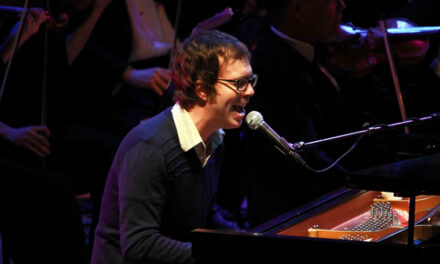The members of the New Zealand String Quartet appeared intoxicated by the responsive acoustics of the intimate, jewel-like Whitley Auditorium at Elon University. It seemed to inspire some stunning musicianship over the course of three challenging quartets from the Classical era, the Romantic era, and the Twentieth Century. Like several modern groups, such as the Emerson String Quartet, the New Zealanders play standing with the cellist on a raised platform. The members are first violinist Helene Pohl, second violinist Douglas Beilman, violist Gillian Ansell, and cellist Rolf Gjelsten. Ansell, Beilman, and Gjelsten each in turn shared informal remarks before each work placing it in context.
The concert opened with Quartet in G, Op.18, No.2, “Compliments” by Ludwig van Beethoven (1770-1827). With its musical jokes and sudden surprises and twists, violist Ansell said it is Beethoven’s quartet most like those of Franz Joseph Haydn. With its delicate, light textures and its well-concealed difficulties, many musicians such as Michael Tree of the Guarneri Quartet consider it the hardest of all the Beethoven quartets to perform. Each New Zealander played with a gorgeous, warm string tone, crystal-clear intonation, precise attacks, and a wide dynamic range. They brought out all the good-natured humor in the piece.
The Quartet No. 13 in B-flat minor, Op. 138 (1970) by Dmitri Shostakovich (1906-75) is in one continuous slow movement marked “adagio” and is probably the composer’s most concentrated work. Beilman described the heavy culture of terror during the Stalin era in Russia which led Shostakovich to compose works with two levels, a superficial surface covering an anguished, deeper level for those in the know. Some twelve tone techniques, first used in the composer’s Twelfth Quartet, are used in Op. 138 along with such things as col legno, bouncing the wooden back of the bow off the instrument. The New Zealanders gave a riveting performance of this brooding, dark work, playing with great concentration.
The recently retired Guarneri String Quartet, early in their career, in the1970s, broke the “late Schubert” barrier by taking on tour the Quartet No. 15 in G, D.887, by Franz Schubert (1797-1828). The physical demands of touring combined with the effort to perform what cellist Gjelstein called the “epic, almost symphonic dimensions” of the work had discouraged an older generation of chamber musicians from taking it on the road. Schubert’s extraordinary ability to create seemingly endless song-like melodies was everywhere evident. I thought of one of Schubert’s successors, Anton Bruckner, a composer of vast symphonic structures, as I listened to violinist Helene Pohl spin out a theme, or as each of her colleagues took it up in turn, while supported by the other players’ sustained tremolos. The New Zealanders delivered a truly inspired performance with each movement beautifully organized and fitted within an over-arching conception of the whole quartet. Their performance compared favorably with the Borromeo String Quartet’s interpretation, my “gold standard” for judging this work.
Violinist Pohl followed up the Schubert with an encore because the ensemble wanted to revel in the acoustics of Whitley Auditorium. They played a delicate, ravishing string arrangement of Claude Debussy’s “Le fille aux chevaux de lin” (“The Girl with the Flaxen Hair”) from Book I of the Préludes for piano.
Note: The Quartet appeared in Asheville the following day.











